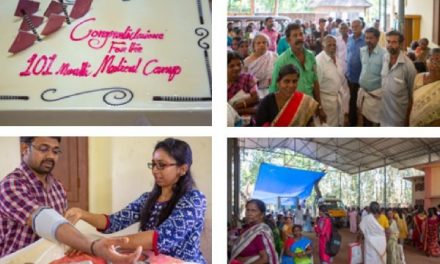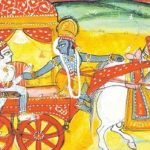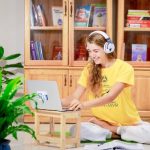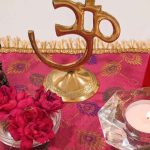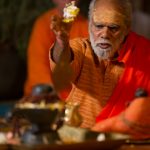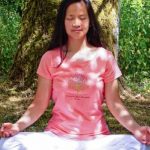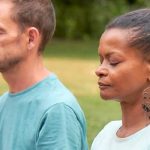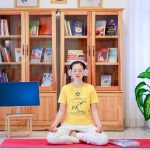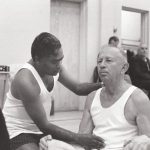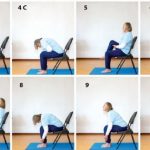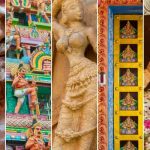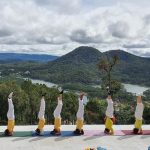 How to Maintain Mental Health
How to Maintain Mental Health
Classical Yogic Methods to Deal With Fears
By Swami Sitaramananda
In this talk, we will try to understand, in the context of the global epidemic, how fear and anxiety create havoc and take away your well-being and mental health, and how faith is so important in dispelling fear.
 We will address the question step by step in 4 points keeping in mind the need for prevention of disease due to poor immune system impacted by negative emotions, and the need for healing emotionally in order to heal physically.
We will address the question step by step in 4 points keeping in mind the need for prevention of disease due to poor immune system impacted by negative emotions, and the need for healing emotionally in order to heal physically.
1. First we need to understand all facets of FEAR, STRESS, and ANXIETY.
2. What are the causes of fear?
3. Some Yogic methods for dealing with fear.
4. Cultivating faith to dispel fear and anxiety.
What is Fear?
Fear is a very strong primitive emotion, present in animals, as it serves a very basic purpose: It helps us to survive. It is at the base of our stress response: fight, flight or freeze.
Things that appear unfamiliar to us, or situations beyond our immediate comprehension, cause us fear. Fear creates imagination of darkness, of falling and distorts the mind. Fear is therefore based in unreality. When we are fearful, we become paralyzed and lose our faculties. We freeze, unable to do anything to solve our problem. Fear is of two kinds, normal fear and imaginary fear.
According to Swami Sivananda, the percentage of normal fear will only be five percent whereas imaginary fear will come to ninety-five percent. Normal fear is healthy. It paves the way for one’s progress; it preserves life. So in the context of the possible virus infection, we wash our hands, clean our handrails, stay put and avoid socializing, etc. Imaginary fear causes diseases, as it depletes all energy and produces uneasiness, discomfort and disharmony, etc.
Examples of imaginary fear
You might be afraid that you will get infected and there is no cure, you might be afraid that your business will collapse and you
will be destitute, that you will lose your job as the companies downsize themselves, that your kids will not be able to study, that your husband’s staying at home will lead to change of the relationship dynamic causing
frustration and divorce, etc.
Some behaviors due to fear and panic:
• Hoarding
• Isolation, hatred of others, blameful attitude
• Shame and guilt
• Depression
• Constant tension, hyper vigilance
• Addictions, drink our sorrow away
• Enjoy life while you still can
• “I do not care! “
Stress is the cause of many forms of diseases, especially chronic stress. We have a built-in stress response in our nervous system in the form of the fight or flight mechanism in response to situations of danger to our survival. However, our stress response might not be adequate.
Remember that Stress is subjective and can be changed once an understanding of the causes of our stress is obtained.
5 Causes of Stress
Low prana: Refer to our previous talk about the relationship between low prana and negative thoughts. We can alleviate our stress by increasing the prana through Yoga practice and positive lifestyle.
Negative emotions: Not only fear and anxiety, but also anger, which comes from expectations and desires unfulfilled, can create stress. Grief is another negative emotion creating stress.
Lack of adaptability: If we develop flexibility in mind and behavior, it helps to tackle the cause of our stress.
Existential anxiety: The imminent danger of the virus epidemic might trigger our fundamental anxiety of existence which can be calmed down only by a broader picture about life and death and our sense of meaning.
Karma: We cannot help but ask the question why, and we have to accept our collective karma at this time. The pandemic situation is not sparing any place on earth. We need to ponder over our collective responsibilities.
In short, to build stress resilience in this time we need to increase prana, spend less prana, convert negative emotions into positive ones, be ready to adapt to new situations, have more faith to deal with our existential anxiety and understand our collective and individual karma.
What is Anxiety?
Disruption in life activity might create anxiety. Anxiety is even worse than fear, because unlike fear, we cannot identify its source. Anxiety is fear that has no name. With anxiety, there is no creativity, no productivity, we are depressed and our minds lose the capacity to think clearly.
Anxiety is an emotion like fear is an emotion.
It is usually associated with autonomic hyperarousal and attentive hypervigilance, in which the internal and external environments are monitored intensely for information relevant to the sense of threat.
It is an expression of the life-preserving fight or flight response and is an essential biological mechanism for motivating the organism for action in response to danger.
It prepares us to deal with varied and challenging life situations. It is the reaction to the perception of an external or internal danger.
Under the spell of anxiety, you might find it difficult to maintain normal day-to day activities and you keep feeling anxious in anticipation of calamity or disaster, which might afflict you sometime in the future.
Parents and spouses need to be aware that the children or spouses might be subject to tension, guilt, stress, anxiety, nervousness and worry. They might be replaying the separation anxiety suffered in childhood.
In general, try to leave space, be available but less demanding and perfectionistic, stay calm and empathetic instead of responding with more tension and projected fear. It is a cause for concern if this feeling affects your normal day-to-day activity. Try to establish a routine in daily life and adapt to the situation.
Routine, schedule, normalcy as much as possible, daily discipline serve all to cope with stress. Know that what stresses you might not be what stresses your spouse or children. Know that anxiety is difficult to pin down. It may give rise to vague emotions of discomfort coming from diverse persistent thoughts combined together.
This feeling of discomfort creates an anxious mood, but no one knows the underlying cause. Everyone is able to endure a certain threshold level of anxiety, but please take note that this threshold is different for each person.
The impending sudden rise of the epidemic attack while your daily routine has changed, and the fabric of the society surrounding you changes drastically, makes people suffer from impaired concentration and with all the time now on their hands, people staying home might find it difficult to perform even simple routine tasks.
Anxiety may be non-specific and arise spontaneously with no apparent relationship to any obvious event. This type of anxiety becomes all pervading in the everyday life of the one suffering, which may result in both psychic and somatic symptoms.
children perceiving this as rejection, and keep engaging family in positive community activities while in quarantine.
Symptoms of Anxiety Disorder
Excessive anxiety or worry for long period of time can turn into anxiety disorder, involving worry about possible misfortune to one’s child (who is in no danger) and worry about finances (for no good reason). In children and adolescents, this may take the form of anxiety and worry about academic, athletic and social performance.
When the person is anxious, there are many signs of motor tension, autonomic hyper-activity (muscle aches or soreness, restlessness and easy tiredness, shortness of breath, palpitations, sweating, dry mouth, dizziness, nausea, diarrhea, flushes or chills and frequent urination).
Other signs are symptoms of vigilance or scanning including feeling on edge, exaggerated startle response, difficulty concentrating or mind going blank because of anxiety, trouble falling or staying asleep and irritability.
Symptoms of Panic Attacks
Symptoms last a few minutes. Unexpected, intense terror, shortness of breath, dizziness or vertigo, shaky feeling, palpitations, sweating, abdominal distress, numbness, chest pain discomfort and fear of going mad can be triggered by situations of being outside of home alone, being in a crowd, standing in line or travelling in a vehicle.
Symptoms of Compulsive Obsessive Disorder
Obsessions are persistent ideas, thoughts, impulses or images that are experienced as intrusive, distressful and senseless.
Compulsions are repetitive, purposeful and intentional behaviors that are performed
in response to or to relieve oneself from a tension. Example: handwashing, counting, checking and touching.
Causes of Fear
From the perspective of classical Yoga philosophy, the cause of fear is attachment, our grasping on to illusory things and beliefs. Being attached means we are stuck or bogged down.
Fear is the opposite of letting go.
The first cause of fear is the attachment to the body and the ensuing fear of death.
The nature of our illusions creates fears. There are two classical analogies to help us understand the nature of our illusions.
The first is called the “Snake and the Rope”. A man is walking in the darkness and sees a snake in the path. He is frightened and immediately runs and gets his friend who has a lamp. When they shine the light on the snake it is seen for what it is, a rope.
When we react to situations with fear, we operate out of a limited consciousness. We have forgotten that the sun is shining beyond the clouds. Yet the clouds of fear obscure the light of the sun. We must have faith to seek out the sun when the mind experiences darkness.
Whether we are dealing with specific fear or general anxiety, we need to cultivate the courage to face our illusions and be who we really are.
We need to have the courage to remove our wrong beliefs and identifications, our thinking that we are a certain thing, when really all those beliefs and identifications are simply attachments and not the one we really are, the eternal strong presence within.
Mechanism of Fear
Fear feeds on past experiences that have no independent reality in the present.
Through superimposition we are creating our reality. We attach our meanings, ideas and conditions to people, situations and objects. Our practice is to separate ourselves from these illusions and realize the true nature of REALITY, of our own SELF. Fear and worry cause us to feel overwhelmed or limited.
As a result, we identify ourselves as a victim. We have become powerless to express our potential. Remember the POWER OF NOW. In the Now we can experience the POWER of BEING.
Often times we grow attached to ideas about ourselves, other people and the world around us. We get attached to things the way they were.
We need to introspect and think, because in so doing we come back to the present, feel strong in the present, become creative in the present. This means we are letting go of our ideas how things should be, and we are ready for positive and creative changes:
• Change of the way we make a living (class on line, work at home)
• Change the way we eat (simpler food, cooking our own)
• Change the way we socialize (read books instead of using the internet, relax in nature).
• Change the way we do spiritual practices (more mantras, more prayers, more meditation)
Classical Yogic methods to deal with fears
Depends on your temperament, you can apply the following 4 classical methods, separately or together. Try to see which one is fitting you more at the moment.
A. Karma Yoga methods (active practical temperament) : Think of how to be helpful for others in this situation. Avoid thinking only about yourself. This will open your heart and alleviate anxiety that comes from attachment.
B. Bhakti Yoga Methods (emotional temperament): Surrender to the Divine plan. Trust that all will be well. Learn to relax. Transform fear to faith. We will talk about this more at the end.
C. Raja Yoga and Hatha Yoga methods (analytical temperament , people already having a practice of Hatha Yoga)
• Improve breath-body-awareness with rhythmical breathing exercises and pranayama. Slow down, do restorative Yoga.
• Increase and balance the flow of prana for greater energy and stress resilience. Balance the right- and left- brain activities. This is the key. Another class on prana is upcoming.
• Improve mental and emotional balance by the regulation of breath, movements and concentration of mind. Awareness is important, not to force.
• Increase ojas, the energy of sustenance, of immunity, that comes from your deep heart. Make sure to improve the quality food, not quantity (nervous eating). Also you can increase your mental attitude of trust and devotion. This subtle Ojas will increase your contentment, gratitude and relaxation.
• Increase calm, reduce fear: Use props (blankets, pillows) when doing Yoga practice or when relaxing to create a sense of security, warmth, quiet and support so you and your family members or students will feel safe to let go of defences, to calm the senses and mind. Do only comfortable postures.
• Experience physical, mental and emotional relaxation. Increase the right attitude for life – detachment.
• Experience connection with one’s Self and others through deep relaxation, slow deep exhalation. Detachment from body, mind and emotions.
• Teachers need to be gentle, encouraging and calming. The same as in trauma sensitive yoga guidelines.
D. Jnana Yoga methods (for intellectual philosophical temperament): Remember the True Self, the Atman, the Soul untouched by diseases and separation. Assert your Healthy Self. Do Self-enquiry, you are not the body nor the mind. Remove the veils of fear by exercising your thinking and discrimination and by detachment.
What is faith?
Replacing fears and anxieties with faith We need to cultivate faith, which will replace knowledge and help us to be calm in the face of calamity or diseases. We need to not only to rekindle our own faith, but also help others to develop faith.
WHAT TO DO:
We need to nurture the 3 types of faith:
1. Faith in own self (reconnect with One’s core self): Self-reliance, which may be the same as faith in one’s Self, means we must rely on our own inner strength, dwelling within us as opposed to relying on an ego self. Fear exists when we don’t know the Truth about the Self (the Atman). Until we have such knowledge of the Self from our own direct experience, we must rely on faith, in order to progress in our life. Ultimately faith is replaced by direct experience of the Self. Truth or Knowledge can be glimpsed intuitively, even if we do not have a name for it.
So calm down and trust yourselt. One student approached me very worried because she had a cough and she just travelled back from England and wondered if she should go to the hospital and be tested. I told her: “Look within, ask yourself the question, “Am I going to die soon? Am I healthy?“, to which she nodded.
I sent her to the hospital and the doctor said it is a common flu and she should just rest. There is no COVID-19 test available anyway unless she is ready to travel to another city. She did not go, but I believe that she regained confidence and overcame her fears by being asked to find the answer from within.
The Truth that will set us free from all fears, resides inside of us, but it is a long, hard journey to find it. However, we must start to walk on that journey with humility and sincerity. We lack experience in the beginning, as we do not really have a clue
where to look when trying to look within. In that journey faith keeps us going.
2. Faith in nature and the supreme intelligence (i.e. cooperate with Natural Laws for healthy living and improve immunity).
Meditate, shift consciousness from the past to the present. Try to see a bigger picture and channel the emotions into devotion and the courage to face our illusions. Faith in God springs from an inner feeling that there is something greater than you, a supreme being that indwells one’s essential spirit.
When one is enriched with abiding faith, one is able to recognize God’s grace operating in all things. We are on a journey of self- discovery to uncover the truth of whom it is that we are, a journey guided by faith. We can think of faith as the bridge that carries us from one experience of grace to the next.
3. Faith in the teachings and the practices. The sacred teachings say that you are like the Shining Sun untouched by fears and diseases. There are days when clouds fill the sky and we can’t see the sun. But you know the Sun is there. To regain vision of the Inner sun, we must learn to clear away the impurities of the mind by theobservance of the Niyamas.
• Ethical guidelines of conduct to purify: Practice of asanas, pranayama, for example)
• Contentment (turning mind inwards)
• Austerity (renunciation, discipline, endurance, simple life)
• Self study (introspection)
• Self-surrender. Self-surrender means accepting what is; letting go and letting God’s will prevail. Let it be. Bear the consequences of past actions coming in the present. Have faith that eventually everything will pass. We must also practice endurance and know that the journey is not going to happen overnight. The challenge of enduring past karma is learning not to react or retaliate. Forgive and forget.
GUIDANCE ON WHAT NOT TO DO
1. Avoid negative company with those who believe in the wrong things. This is the
surest way to kill your faith and increase your fear. Therefore, avoid negative people. This includes media as negative company, as well as internet gossip sites.
2. Following the Yamas: Practice patience with Self and others. Do not be angry or violent. Do not lie. Do not steal. Try to turn inward beyond the senses. Let go of our greedy tendency. Live a simple life; the more one depends on material objects the more fear one will have.
Everything is a test of faith: we have the choice to spiral down or spiral up. We need to learn how to overcome doubts and fears, how to renew our faith and not to lose faith, which makes us weak and move in the wrong direction.
Often disease brings doubt and guilt, feelings of rejection, of not having self-worth, or loss of faith.What we must keep in mind is that any kind of faith will make us feel strong, even when we have faith in the wrong thing.
So we might have faith in the doctor or in the medicine, in the type of treatments we follow.
The opposite of faith is doubt. Doubt will make us feel weak. Doubt comes when we lose faith. We become doubtful in the underlying order of the Universe or of Nature. This is because our expectations are not being met. When something happens that fails to meet our expectations, we lose faith in God, the Universal law and ourselves. But remember, our journey towards fearlessness implies renewing ourselves.
Keep your mind and heart open. When temporarily losing faith, try to find out the cause of our doubt,which is always a certain aspect of our ego, and embrace again your truth in the form of faith. Company with those who have no doubt is very powerful in removing doubts.
Swami Sitaramananda is Acharya of the Sivananda Yoga Vedanta Centres. She is the director of Sivananda Ashram Yoga Farm, California and the Sivananda Ashram Resort and Training Centre in Da Lat, Vietnam.



